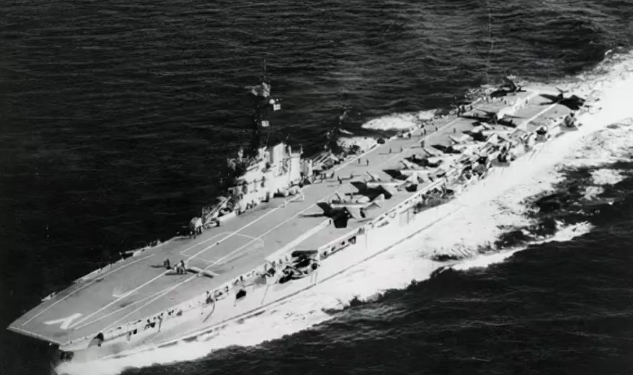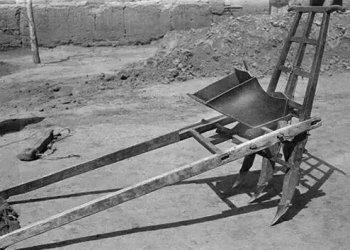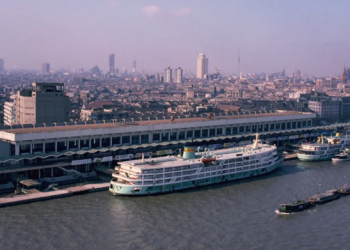On an afternoon in June 1985, a young naval officer suddenly received an urgent order: head south to Guangdong. When he hurriedly arrived at a shipyard in Zhongshan, Guangdong, he was utterly stunned. In front of him stood a colossal object—an aircraft carrier.
The young naval officer still vividly recalls the shock he felt at that moment: “We saw this enormous thing, standing there like a building several stories high. It was all of our first time seeing an aircraft carrier, and we knew nothing about it. Not to mention the catapults—at that time, I didn’t even know what those whip-like antennas on the carrier were for.”
Living in the internet age, it’s hard for us to understand the magnitude of this shock. After all, today, with just a smartphone, we can watch or read anything we want. But in the 1980s, information sources about military equipment were scarce, and a single photo of an aircraft carrier from a foreign magazine could be studied for weeks. So, what about seeing an actual 20,000-ton aircraft carrier right in front of your eyes?
This aircraft carrier was China’s first jet-launch capable carrier—the Melbourne.
Unfortunately, it was scrapped. Years later, Western media still harbored resentment, claiming that China had imported the decommissioned Melbourne aircraft carrier under false pretenses, disassembling it to learn the basic structure and design of an aircraft carrier. But, in reality, it wasn’t as underhanded as they suggest. The Melbourne was entirely an unexpected windfall.
The story begins in 1982, when the Australian Navy decided to decommission the Melbourne earlier than expected. The Melbourne had originally been the British carrier HMS Majesty. Construction began on April 15, 1943, and the ship was launched on February 28, 1945. However, after just two months of fitting out, Germany surrendered. The British were left in a dilemma: Should they continue building the ship at great expense, even though the wartime demand had disappeared? Or should they scrap it? They had already built most of it, and it seemed a waste to dismantle it.
After much negotiation, the British managed to persuade Australia to take over the ship. To meet Australia’s needs, the British spent over five years modernizing the Majesty, adding a BS-4 steam catapult and a “Fresnel” lens for landing assistance, thus making it capable of launching jet-powered aircraft. Once completed, the Australians renamed it the Melbourne.
Though the Melbourne never participated in combat, its destructive capability was anything but lacking—though, ironically, it caused harm mostly to its own people. On October 28, 1957, just a year and a half after entering service, the Melbourne collided with the merchant ship Blue Star and began its infamous “bump-and-crash” legacy.
On February 10, 1964, the Melbourne made headlines again when it sliced through the Voyager destroyer, resulting in the tragic deaths of 82 sailors. Then, on June 3, 1969, the Melbourne collided with a U.S. destroyer, sinking it and claiming the lives of 73 crew members. The series of accidents continued when, on July 11, 1974, the Melbourne collided with a passenger ferry. Two years later, on July 24, 1976, it struck a Japanese cargo ship in Sydney Harbour.

The Australians were truly fed up. Although the Melbourne had never seen battle, its record of accidents almost exceeded that of the entire Australian Navy. In 1982, the Australian military decided to retire and dismantle it prematurely. Here’s an interesting tidbit: dismantling ships is not at all easier than building them. The process of sorting and removing metals and parts can be incredibly exhausting. Not only does it cause serious pollution, but it also requires a significant amount of manpower and valuable dry dock space. When you factor everything in, the cost of dismantling a ship can often exceed that of building one. That’s why, in many cases, developed countries, to save money and effort, simply sell off decommissioned ships and let others handle the dismantling.
In March 1985, the Guangzhou Shipyard won the contract to dismantle the Melbourne and prepare to tow it back to China. But when the ship arrived at the shipyard, it left the military representatives (those sent by the military to supervise quality at factories) utterly stunned! Where did this gigantic thing come from? Back then, China’s largest naval vessel was only about 3,000 tons. Although the Melbourne was considered a light aircraft carrier, it weighed over 20,000 tons. When the ship docked at the yard, it truly stood out like a crane among chickens. The military representatives were shocked, and upon further inquiry, they discovered that Guangzhou Shipyard had quietly brought in an aircraft carrier for dismantling. While the ship had been technically disabled—its weapons systems and electronics had been removed, and even the rudder had been welded shut—it was still, after all, an aircraft carrier! The research value was enormous.
The military representatives immediately reported this to the Navy Commander. And who was the Navy Commander at the time? It was Liu Huaqing. We all know that Liu Huaqing was a staunch supporter of aircraft carriers. When he received the news, he was thrilled and immediately ordered the Navy to organize a team to conduct a thorough investigation of the Melbourne. This led to the earlier scene, where a deputy researcher from the Navy’s Equipment Research and Development Center, exhausted from the journey, arrived in Guangzhou. The deputy researcher was none other than the well-known Zhang Zhaozhong, who would later become the Vice Director of the Navy’s Equipment Research Institute and the “General of the Bureau of Military Experts,” famously known for his remark about “even a shared bicycle can’t be swept by a sesame-fleet.” Zhang Zhaozhong, the Rear Admiral we all know and love.
To be honest, that inspection was far from thorough. On one hand, the inspection team was a loose collection of personnel drawn from different naval units and research institutes who didn’t really know one another; the inspection plan was, in effect, written only after they first saw the carrier—and each sub‑team pursued its own priorities. On the other hand, time was extremely tight: Guangzhou Shipyard was in a hurry to break the ship up for profit and allotted the military less than a month. That amount of time was simply insufficient to survey and map an entire aircraft carrier.
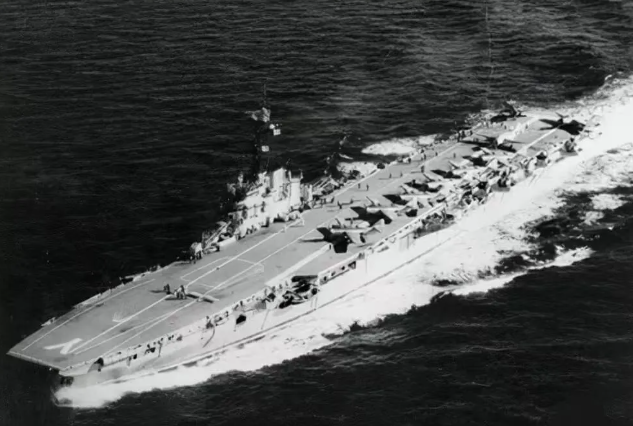
In order to race against the clock, the survey team crammed themselves into the nearby, sweltering work tents and began room‑by‑room mapping of the ship’s interior, measuring compartment after compartment to decipher the carrier’s design details. Zhang Zhaozhong later recalled that the Melbourne had no propulsion at the time (and therefore no power): the ship’s interiors were pitch‑black. Amid the piled‑up refuse they found discarded watch logs and abandoned personal belongings. Each researcher carried a flashlight and crawled through the ship’s hull—dozens of decks high—slowly building up a picture of the main structural layout of a modern aircraft carrier and cataloging its principal onboard systems.
During the survey Zhang made a keen observation: although the ship had been rendered an empty hulk, the steam catapult, the approach/landing aid system and the arresting gear were all still physically present. The damage inflicted on them had been only superficial—some perforations and functional disablement—rather than total destruction. In other words, by copying what they could see, China could plausibly reproduce a steam catapult of its own.
Acting on that insight, Zhang’s team made a concrete proposal in their final assessment: find a way to preserve the Melbourne’s catapult and landing‑assistance systems so they could serve as study objects for developing China’s future catapult‑equipped carriers. They could not have anticipated then the far‑reaching consequences of that recommendation. That single report would help open the door to China’s program to develop catapult‑type aircraft carriers — a journey whose first technical step would later be known as Project 891.
The 1980s was a particularly unique period in the history of China’s national security. On one hand, the relationship between China and the United States had begun to thaw, while the Soviet Union, preoccupied with the Afghanistan War, had little time to focus on the East. Meanwhile, Vietnam posed little threat, essentially a mere nuisance. This period could be considered the time of least national security pressure since the founding of the People’s Republic of China. On the other hand, China was acutely aware of the vast disparity in military equipment and technology between itself and Western nations, leading to a deep sense of military anxiety.
The idea of large-scale modernization of military equipment seemed appealing, but the “army must endure” directive was in effect, and military factories were so poor that they were nearly begging for aid. A full-scale upgrade of equipment was, therefore, far from realistic. In the midst of this, news emerged of the discovery of oil and gas resources in the Spratly Islands (Nansha Islands). At that time, China’s major oil fields, including the Daqing Oilfield and Shengli Oilfield, had already passed their peak production periods. The cost of extracting from them was rapidly increasing, making the exploration and development of the South China Sea’s oil and gas reserves a new hope for China’s energy security.
However, the problem lay in China’s almost nonexistent ability to maintain a military presence in the Spratly Islands. There were no airports on these islands and reefs, and fighter jets flying from Hainan Island would need to turn back within ten minutes due to fuel shortages. So, why, after the March 14th naval clash in 1988, did China, having successfully occupied the Goni Reef, Da Xian Reef, Nairo Reef, and Qiong Reef, eventually choose to abandon them? The answer was simple: the navy was just not strong enough, and they could only hold onto the larger, more strategically important positions, leaving the smaller ones behind.
Therefore, China needed an aircraft carrier that could be flexibly deployed in the South China Sea. Whether it was to protect the sovereignty of the Spratly Islands or safeguard vital trade routes, an aircraft carrier was indispensable. In 1985, the Navy Equipment Certification and Research Center established the Aircraft Carrier Certification Center. In 1986, under the leadership of Liu Huaqing, the first naval strategy seminar was held in Beijing. During the seminar, it was unanimously agreed that China should not shy away from the challenges ahead. If China did not begin developing aircraft carriers within the next 10 years, it would still face difficulties even after that. The need for early research and development was clear, and work on aircraft carrier development needed to start as soon as possible.
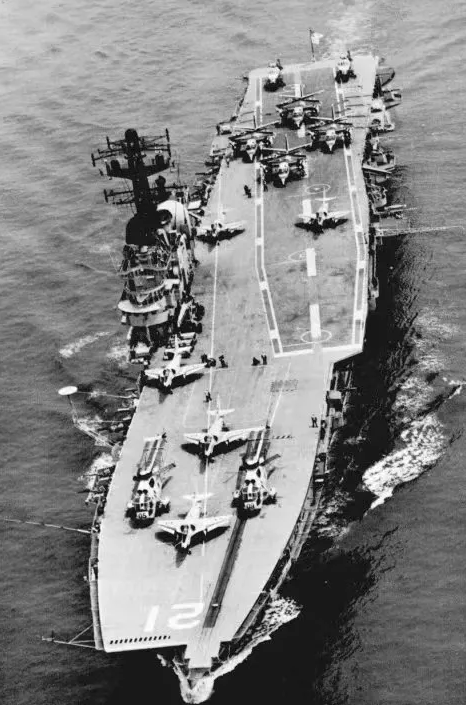
In January 1989, before Liu Huaqing left his post as the Commander-in-Chief of the Navy, he managed to secure 40 million yuan in self-raised funds. With this funding, he officially launched China’s first post-reform aircraft carrier project, codenamed “Project 891.”
Project 891’s rough outline was this: a medium‑sized carrier, conventionally powered, in the ~40,000‑ton class, fitted with steam catapults and carrying indigenously produced carrier aircraft — in short, the much‑rumored early “medium‑conventional‑catapult” carrier that military enthusiasts later dubbed the “mid‑con‑cat” concept.
That said, although Project 891 was formally approved, it did not at the outset target a single, clearly defined ship type. Rather, it functioned as the launch of systematic pre‑research into the carrier’s various subsystems. In Liu Huaqing’s own words, “We must build carriers; by the year 2000 carriers should be in our strategic thinking. We need not lock the program to a single hull design right now — first do the pre‑research.”
After about a year and a half of technical study and debate, the 891 project team delivered a multi‑hundred‑thousand‑character feasibility dossier that sketched a practical path for China’s carrier development. The report established a guiding principle: base development on domestic capabilities, do not rule out selective foreign introduction, but retain sovereign control over the key technologies.
Which technologies were considered “key”? The study singled out three priorities:Carrier‑capable fixed‑wing aircraft — designing, adapting or selecting fighters and support aircraft that can operate from a carrier deck and survive the harsher, salt‑wet, high‑tempo environment of naval aviation.Catapult systems — the steam catapult was treated as a cornerstone technology for launching heavier, faster jet aircraft from a flat deck.Arresting / barrier systems — robust, reliable systems to recover aircraft safely aboard ship.
On the question of carrier aircraft, the 891 study did not settle on a single airframe; instead it explored multiple concept options in parallel. Proposals examined in the reports ranged broadly, from vertical/short‑takeoff ideas and adapted land fighters to larger carrier‑borne types and even specially modified transport airframes for airborne early warning roles. Proposals under consideration included concepts such as a V/STOL derivative of the J‑6, adapted carrier versions of J‑7 and J‑10 family fighters, and an AEW platform based on modified transport airframes (for example, derivatives of the Y‑7 were discussed as a basis for early warning conversions). Each option carried different trade‑offs in weight, range, sortie rate and the degree of ship‑borne systems required.

In short, Project 891 was less a ship‑design contract than the formal beginning of a national program to master the engineering building blocks of a modern, catapult‑equipped carrier force: aircraft, catapults, arresting gear, and the associated operational doctrine. Its emphasis on indigenous mastery of the critical subsystems — while remaining open to selective technology transfer where practical — set the technical and strategic groundwork for China’s later carrier development.
And what about the catapult and arresting systems? The options were far narrower — after surveying the field, the only practical short‑term route was to copy the set of catapult and arresting gear found on the Melbourne. Thanks to Zhang Zhaozhong’s recommendation, even though the Melbourne was being broken up, its catapult machinery and a portion of the flight deck were preserved, becoming a priceless technical reference for China’s carrier catapult program.
In fact, although the Melbourne was laid down in the 1940s and modernized in the 1950s, its catapult performance was not as obsolete as one might assume. The reason is straightforward: nearly all operational steam catapults in the world trace their lineage to a single technological root. After the Second World War, the advent of heavier, faster jet aircraft created a new problem for carrier aviation. Propeller aircraft had been relatively light and slow and could be launched from deck runs without assistance; early jet aircraft, however, required much higher launch speeds and could not rely on the short deck length of contemporary carriers.
To solve this problem the British began developing re‑usable catapult systems capable of launching jet fighters from carriers. After several years of work, British engineers in the early 1950s produced the world’s first slot‑cylinder steam catapult, known as the BS‑1. The BS‑1 was conceptually simple: it consisted mainly of a cylinder, a piston, a shuttle (or slider), and associated steam piping and control valves. In operation, high‑pressure steam from the ship’s boilers is admitted into the cylinder and acts on the piston; the piston’s linear motion drives the shuttle, which is attached to the aircraft via a bridled holdback or shuttle hook. As the shuttle accelerates along the catapult track it drags the aircraft forward, rapidly increasing the aircraft’s speed until it reaches flying speed and lifts off the deck.
From an engineering perspective, the steam catapult converts stored thermal energy (boiler steam) into kinetic energy very quickly and controllably, enabling heavy aircraft to achieve takeoff velocity within a very short stroke length. The system’s key performance parameters include the available catapult stroke length, the peak and average tractive force, the acceleration profile (which must be survivable for the airframe and pilot), and the reliability and repeatability of the steam supply and control system.
The arresting (or “arrestor”) gear — the counterpart that brings aircraft safely back aboard — is equally critical. Arresting systems generally consist of one or more transverse cables (the arrestor wires) stretched across the landing area, hydraulic or mechanical energy absorbers (the purchase or deck‑edge machinery), and engagement hardware on the aircraft (the tailhook). When a landing aircraft contacts an arrestor wire, the sudden load is transmitted to the purchase system, which dissipates the aircraft’s kinetic energy through controlled hydraulic resistance or mechanical braking, bringing the aircraft to a safe stop in a few dozen metres. Both catapult and arresting systems must be carefully matched to the aircraft types intended for operation: heavier aircraft need more powerful catapults and stronger arresting gear.
Because the BS‑1–derived architecture had been widely fielded, the Melbourne’s preserved apparatus offered China a ready template: a physically intact example of steam piping runs, cylinder housings, shuttle rails and deck interfaces that could be inspected, measured, and reverse‑engineered. Even if some components had been superficially disabled (punched holes, removed controls, or welded parts), the basic geometry, structural members, and mechanical interfaces remained — exactly the kind of “walking skeleton” that accelerates learning.
Therefore, the pragmatic conclusion from the 891 pre‑research was obvious: if China could reproduce a steam catapult in principle by imitating the Melbourne’s layout and materials, then the technological barrier to a catapult‑equipped carrier was surmountable. That insight — preserve what could be preserved, study it exhaustively, and build domestic capability around those reference points — turned a lucky encounter with a decommissioned carrier into the technical seed of China’s later efforts to field catapult‑launched naval aviation.
After 1,600 catapult launches and detailed refinements, the BS-1 steam catapult was finally perfected and officially incorporated into aircraft carriers, renamed the BS-4.
Upon hearing that the British had successfully developed a mature catapult, the Americans immediately came to inspect it. After seeing it, they were astonished.
With the investment in the 891 Project, the Chinese gained a solid understanding of aircraft carrier design and operations. They even started training future aircraft carrier commanders through a “Pilot Commander Course” in advance.
Opportunities often favor those who are prepared. On March 3, 2002, the Varyag finally arrived at China’s Dalian port after enduring many challenges, reigniting China’s dream of owning an aircraft carrier.
China obtained valuable technical documentation regarding catapults and the Soviet-era superheated boiler technology, as well as new steam propulsion systems. After years of relentless technical research, as well as tests in extreme cold and heat, the research team finally mastered the domestic steam catapult technology! At this point, it had been 25 years since China first encountered the steam catapult from the Melbourne.

But the real challenge was not just mastering the technology — it was about being able to mass-produce it. At that time, domestic shipbuilding research institutes could not produce the high-precision piston cylinders required for the catapult, which needed extremely advanced cold-drawing processes.
So what did they do? You’ve probably heard the story. When China was struggling with the problem of arresting cables, they stumbled upon a clue — Hebei Giant Rope was supplying arresting cables to the U.S. Newport News Shipbuilding, and China obtained the cables without any trouble, saving significant R&D costs. The catapult issue was similar. When the research team faced challenges in producing the catapult’s cylinders, someone had an idea: why not visit private enterprises and explore their capabilities?
Lo and behold, they found just what they were looking for — a private company in Jiangsu. This company specialized in hydraulic cylinders and cold-drawing machines. Since they were already making hydraulic cylinders and cold-drawing machines, manufacturing the perforated cylinders for the catapults seemed like a straightforward task. It seemed easy enough, but when the job was actually handed over, the company felt immense pressure, as they had never worked on something of such length and precision before. The chief engineer of the company said, “The entire linearity must be controlled within 2 millimeters, and the dimensional tolerance must be within 0.01 millimeters, which is one-seventh of a human hair, for something that stretches several hundred meters. Achieving such precision with other processes seemed almost impossible at that time.”
This represents just a small part of the struggle and ingenuity involved in China’s aircraft carrier journey — from acquiring foreign technology to adapting it domestically, and overcoming substantial manufacturing hurdles in the process. This combination of effort, persistence, and collaboration with private enterprises ultimately laid the groundwork for China’s independent carrier capabilities.
Fortunately, Professor Zhang Gaifan, a pioneer in China’s naval electrical engineering field and founder of the electrical engineering research team, recognized Ma Weiming’s exceptional talent. He took him under his wing and guided him through his master’s studies, even recommending him to pursue a PhD at Tsinghua University’s electrical engineering program.
In 1996, Ma Weiming graduated with a doctorate and reached the pinnacle of his field. After graduation, Ma Weiming, as if “cheating” at life, swiftly tackled a series of challenging technical problems, including resolving the inherent vibration issues of the submarine’s twelve-phase generator system, developing the shaftless pump spray system for nuclear submarines (which is now installed in China’s new nuclear submarines), and solving problems in integrated power systems for naval vessels. By 2001, at just 41 years old, Ma Weiming was elected as an academician of the Chinese Academy of Engineering.
For most people, reaching the position of “outstanding young talent” or “elite young scientist” by the age of 40 is already an impressive achievement. But for Ma Weiming? Just five years after earning his PhD, he became an academician! Ordinary people simply cannot compare with a genius like him. It’s truly inspiring—perhaps even frustrating for the rest of us.
However, Ma Weiming’s expertise was originally in electrical engineering. So how did he suddenly transition to working on electromagnetic catapults? This shift is tied to a project he was involved in. In 2000, Shanghai and Germany signed an agreement to introduce a maglev train, planning to build China’s first maglev high-speed rail in the city. While assisting with technical research for this project, Ma Weiming had a breakthrough idea: “If electromagnetic force can push trains, can it also propel aircraft on aircraft carriers?” This was an incredibly advanced concept. At the time, even the United States had only proposed it theoretically.
In 2006, Ma Weiming applied for a 1 million RMB budget for a feasibility study on electromagnetic catapults. In just a few months, he completed the research report. However, at the time, the 048 Project was already focused on developing steam catapult technology, so there was no time to focus on this theoretical electromagnetic catapult technology. When Ma Weiming continued to apply for funding to develop a prototype, his request was turned down.
However, Ma Weiming was persistent. He firmly believed that the electromagnetic catapult was the right direction. Since the higher-ups refused to fund it, he decided to cut costs from other research projects. He managed to save 20 million RMB and, in just two years, developed a 1:10 prototype for the electromagnetic catapult system. At the end of 2008, during the naval engineering university’s evaluation meeting, this small prototype shocked over 80 experts. It was noteworthy that, in September 2008, General Atomics in Mississippi, USA, had just completed the prototype testing for the U.S. Electromagnetic Aircraft Launch System (EMALS)!

Ma Weiming was clear: China’s first aircraft carrier with a catapult should not be equipped with a system that is already outdated from the moment it’s born. Just because the Americans couldn’t handle medium-pressure DC doesn’t mean the Chinese can’t. Just because the Americans couldn’t solve the problem of supercapacitors and had to use flywheel energy storage, doesn’t mean the Chinese can’t! To lead, China must surpass the U.S. This wasn’t out of personal ambition—Ma Weiming had no deep hatred for the steam catapult development team. It was entirely for the future of China’s aircraft carriers.
For this, Ma Weiming was willing to risk everything—his honor, his status, his reputation, and even his life. He was determined to challenge the steam catapult route. After all, he became an academician at 41, and since the country treated him as a national treasure, he was ready to repay the nation in kind!
In the end, after careful deliberation by the higher-ups, a decision was made: both sides would receive funding, adopting a dual-track approach. The gamble was made to ensure a big win, and even if things didn’t go as planned, there would still be a safety net. At the end of 2011, Ma Weiming’s electromagnetic catapult project was officially approved, and he was finally able to fully pursue his ambitions. After years of hard work, Ma Weiming’s team successfully completed the entire set of electromagnetic catapult systems for aircraft carriers. Through rigorous testing, the system met all the design goals!
This means that the electromagnetic catapult, which has recently stirred so much excitement and brought tears of joy to many, is actually a technology that has been around for over ten years. It’s already outdated but still capable of being demonstrated. On June 17, 2022, the Type 003 aircraft carrier, Fujian, was completed and launched. On September 22, 2025, the Fujian officially announced that the J-15T, J-35, and KJ-600 carrier-based aircraft had completed successful electromagnetic launches and arrested landings, marking the official entry of the Chinese Navy into the “electromagnetic catapult era.”
When ordinary people, when everyday citizens, are willing to dedicate their lives to the flow of history, the great rejuvenation of a nation ceases to be a distant dream and becomes a reality that is actively being written. The development history of China’s aircraft carrier catapults is nothing short of a grand epic—one where individual fates and the nation’s future intertwine in the most heroic, intense, and tragic way. Even in the face of immense pressure from the times and countless setbacks, there are always those who stand tall—some burying their heads in hard work, some fighting relentlessly, some striving with all their might, and some letting go with tears in their eyes.
In these moments, individual glory and disgrace are insignificant. The course of the nation’s destiny is determined in a single stroke.
